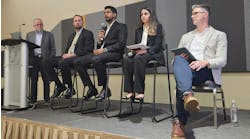Commercial real estate can be a fast, dynamic, and unforgiving landscape. In many ways, CRE professionals are the keepers of the keys in the building industry, identifying new, saturated, or undervalued markets, driving developer interest, winning over tenants, and steering demand. For every landmark, centerpiece development that makes the news, many more falter or barely break even.
The business side of the design and building industry has long fascinated Kim Pipkin, founder and principal of Black Kite Consulting in San Anselmo, Calif., where she is also a planning commissioner. With her multidisciplined background and networking skills, Pipkin has held several leadership roles across the AECO sector in marketing, business development, client engagement, real estate brokerage, city planning, and diversity, equity, and inclusion initiatives. She shares what people in her market are expecting from their smart building technologies.
SBT: What do you see in the future for smart buildings?
Pipkin: The purpose of the built environment is to serve people. Smart buildings are about making day-to-day life more manageable at home or the office using technology. The driving factor of smart building design is to create a safe and comfortable environment for occupants that is economical and efficient.
Smart buildings include systems that connect us to everyday objects and to the internet through our devices. Smart building experts—and I’m not one—understand the Internet of Things. IoT is one of the most important technological advancements in this century. It makes communication possible between people and the processes they need. Every new building planned now and going forward will probably have smart design elements.
Interest in smart building upgrades has increased significantly with the onset of COVID-19, particularly in CRE. The ability to monitor HVAC systems and control building access from a central and remote platform is a sought-after capability. As workers return to the office and companies consider permanent hybrid roles, developers, engineers, and building managers are thinking about how to implement new technology that supports the demand. The smart building market has many unanswered questions; we haven’t worked it all out.
Every new building planned now and going forward will probably have smart design elements.
A friend who manages a 500,000-square-foot office building was concerned about tracking tenant density should an evacuation occur. Typically, a tenant assigns a staff member who coordinates this activity with building management. Now that employees are working sporadically in the office, will the life-safety floor warden always be available? This situation resulted in the development of a proprietary video game training to help tenants evacuate the building. The video functions like the old-school Pac-Man game where the avatar must navigate the space to find the emergency exit.
In my opinion, buildings that do not have smart tools are not the most attractive for tenants looking for space—even if the rent is cheaper. Retrofitting structures to accommodate smart tools can be cost-prohibitive. Plus, the time to install the infrastructure could mean the technology is outdated when the project is complete.
What else are people expecting from their buildings?
People want the latest tech, especially in the Bay Area, where I live. This is the center of the universe for advanced technology. With U.C. Berkeley and Stanford universities anchored here, there’s an assumption that some engineer will create the next best smart building gizmo because we have the talent and money.
Newer buildings here are designed to be people-centric. Since the pandemic, employers are rethinking how office spaces will work for employees who prefer being remote or in the office. Designers and engineers are creating meeting spaces that mimic the actual office and feature videoconference displays for virtual participants to feel as if they are alongside their in-person colleagues. The digital twin platform comes to mind.
How has the AECO industry evolved over your career?
Forward-thinking firms are leaders in integrating technology into smart building design. Engineers, such as Arup, are on the forefront of smart building design. Developers interested in how building operating systems affect the bottom-line partner with engineers before engaging an architect to design the exoskeleton and interior of a building. Also, involving a general contractor is mandatory to control costs—because cost is the driver.
How would you like to see business practices or philosophies change?
I would like to see business leaders recognize that the best ideas and best practices are not exclusive to the C-suite. Creativity and innovation do not reside with a selective group of people or with those who fit a certain criterion. Different perspectives create opportunities for the greater good. Not one person holds all the keys to success.
Creativity and innovation do not reside with a selective group of people or with those who fit a certain criterion.
Have you seen this changing over your career tenure?
Over my 25-plus-year career, I haven’t seen significant change. It’s been glacial. I have enough experience to confidently say that change has been difficult and not easy—but we are making strides. Companies who want to create sustainable growth or a legacy will include everyone’s voice, from the receptionist to CEO. Leadership will be more inclusive, look a bit different, and reflect the demographics of our population.
Much of my career has been in marketing and business development for the AEC industry. For eight years, I was a partner in a boutique public relations firm specializing in CRE brokerage and development. The infinite loop of the profession has brought me full circle to CRE because it is fundamental to the success of the built environment. It is also where I, as one of the few Black females in CRE, can make the most impact.



